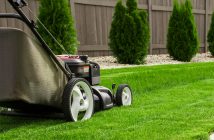A beautiful and healthy lawn demands thoughtful preparation every spring. To achieve a perfect green lawn, you have to invest some time and care. Follow the tips below and have the best looking lawn on the block.
Lawn Equipment
Spring is the perfect time to examine your lawn equipment to ensure it is in prime condition. Carefully check your hose to be sure it is free from leaks. You should also make sure it is not too weatherworn to be serviceable and has a length adequate for your space. See if your sprinklers function properly and give sufficient coverage to your lawn. Service your lawn mower yourself or have a professional look it over. Get your starter, air filter, belts, spark plug, and battery working smoothly, and ensure that your blade is not dull. This is important to for keeping your lawn in its best shape.
Thoughtful Handling
A lawn coming out of dormancy can be easily damaged. Wait for the right time to perform each of your lawn-care tasks, this will vary based on the kind of grass you have. If your lawn consists of cool-weather grass, it is going to grow a little in the spring, be dormant in summer, and thrive in the fall. Avoid aggressive lawn care before the grass has greened.
Post-Winter Cleanup
With the coming of spring, your first goal is to let your lawn dry. Once the lawn is no longer wet, you rake it thoroughly to remove the dead matter. Besides eliminating the thatch, raking helps locate spots on your lawn that need attention.
Liming
Check the acidity of the soil before you set to work. You can conduct this test yourself or enlist the services of an expert. If you find that your soil’s pH is low, consider liming your lawn. An acidic lawn takes some time to balance, so if liming is necessary, prepare yourself for a less than perfect landscape this year.
Seeds and Weeds
Weeds are a problem, but so are patches without grass. Unfortunately, you cannot resolve both problems in the spring since herbicides interfere with grass growth. If you choose to combat crabgrass and weeds, your best course is to use a pre-emergent herbicide to frustrate the germination of unwanted seeds. If your lawn has unfortunately passed the time for using a pre-emergent, try a post-emergent or simply weed manually.
On the other hand, to sow grass seed, you need to take into account your particular variety of grass. If it is cold-weather grass, the optimal time for seeding is when the ground temperature has reached a 50-degree to 60-degree range and the air temperature is above 60 degrees but less than 70 degrees. Warm-weather grass needs temperatures 10 degrees higher than its cold-weather counterpart.
Watering
Dry soil is good for roots, and the roots are at work before you see any growth above ground. However, grass that remains flattened is an indication that your soil is too dry. When the roots have done their work and the blades begin to grow, you can increase your weekly watering to a measure of about 1 inch.
Fertilizing
Cool-weather grass needs fertilizer in the fall, not in the spring. On the other hand, warm weather grass is not ready for fertilizer until it has come out of dormancy and begins growing.
Mowing
Avoid mowing too early, but once your grass appears to be too long–and if it and the ground are dry–feel free to cut it. The general rule is to keep your clippings to a third of the length of the grass blade, but you may want merely to give a trim to even out the early spring growth.
Just as your house needs a spring cleaning and freshening, your lawn requires special post-winter attention. The time and effort you devote to it now, will reward you as this spring.









